DODGE TRUCK 1993 Service Repair Manual
Manufacturer: DODGE, Model Year: 1993, Model line: TRUCK, Model: DODGE TRUCK 1993Pages: 1502, PDF Size: 80.97 MB
Page 1281 of 1502
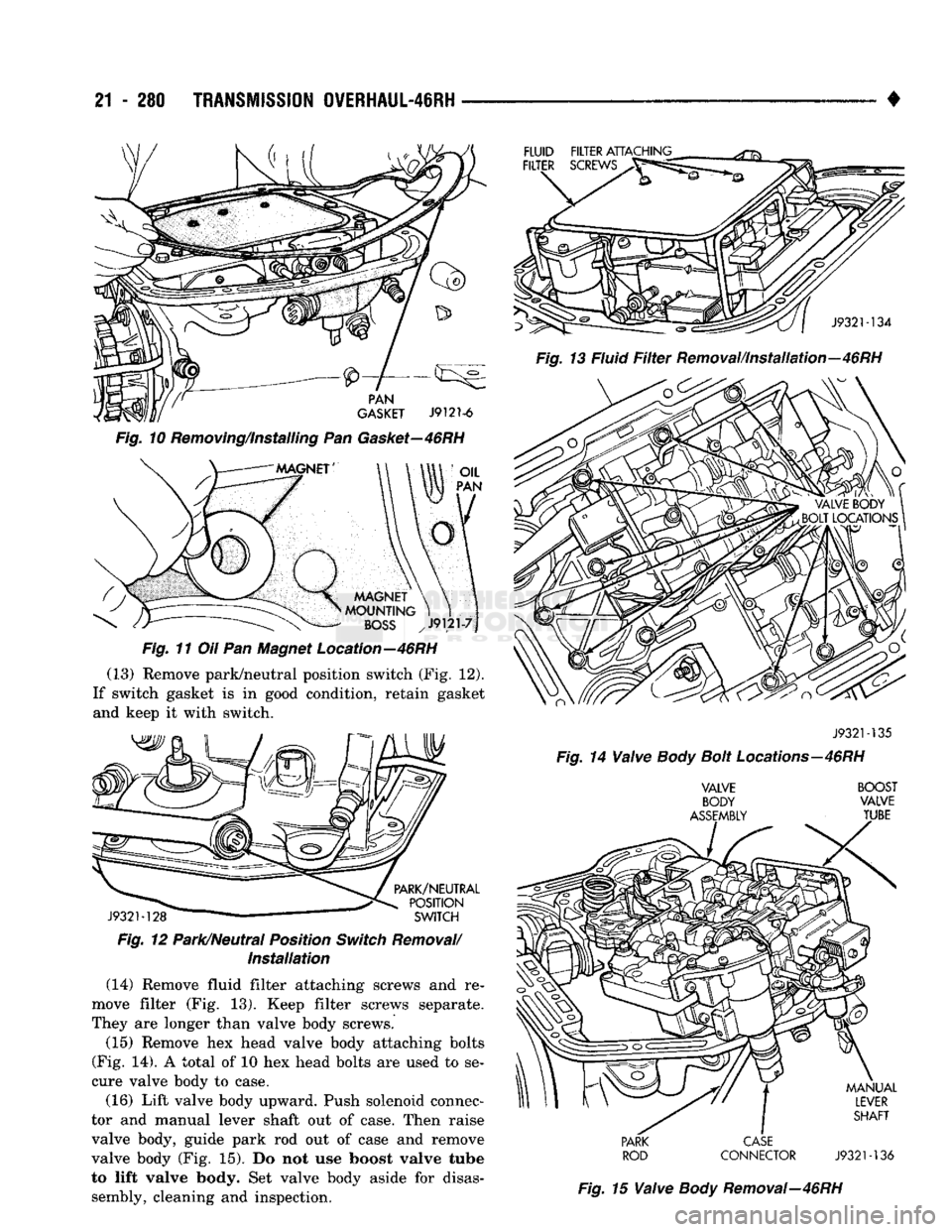
21
- 280
TRANSMISSION
0VERHAUL-46RH
Fig.
11 Oil Pan Magnet Location—46RH (13) Remove park/neutral position switch (Fig. 12).
If switch gasket is in good condition, retain gasket and keep it with switch.
J9321-128
" '
SWITCH
Fig.
12 Park/Neutral Position
Switch
Removal/
Installation
(14) Remove fluid filter attaching screws and re
move filter (Fig. 13). Keep filter screws separate.
They are longer than valve body screws.
(15) Remove hex head valve body attaching bolts
(Fig. 14). A total of 10 hex head bolts are used to se
cure valve body to case.
(16) Lift valve body upward. Push solenoid connec
tor and manual lever shaft out of case. Then raise
valve body, guide park rod out of case and remove valve body (Fig. 15). Do not use boost valve tube
to lift valve body. Set valve body aside for disas sembly, cleaning and inspection.
J9321-135
Fig.
14
Valve
Body
Bolt
Locations—46RH
VALVE BOOST
BODY
VALVE
ASSEMBLY
TUBE
PARK
CASE
ROD
CONNECTOR
J9321-136
Fig.
15
Valve
Body
Removal—46RH
Page 1282 of 1502
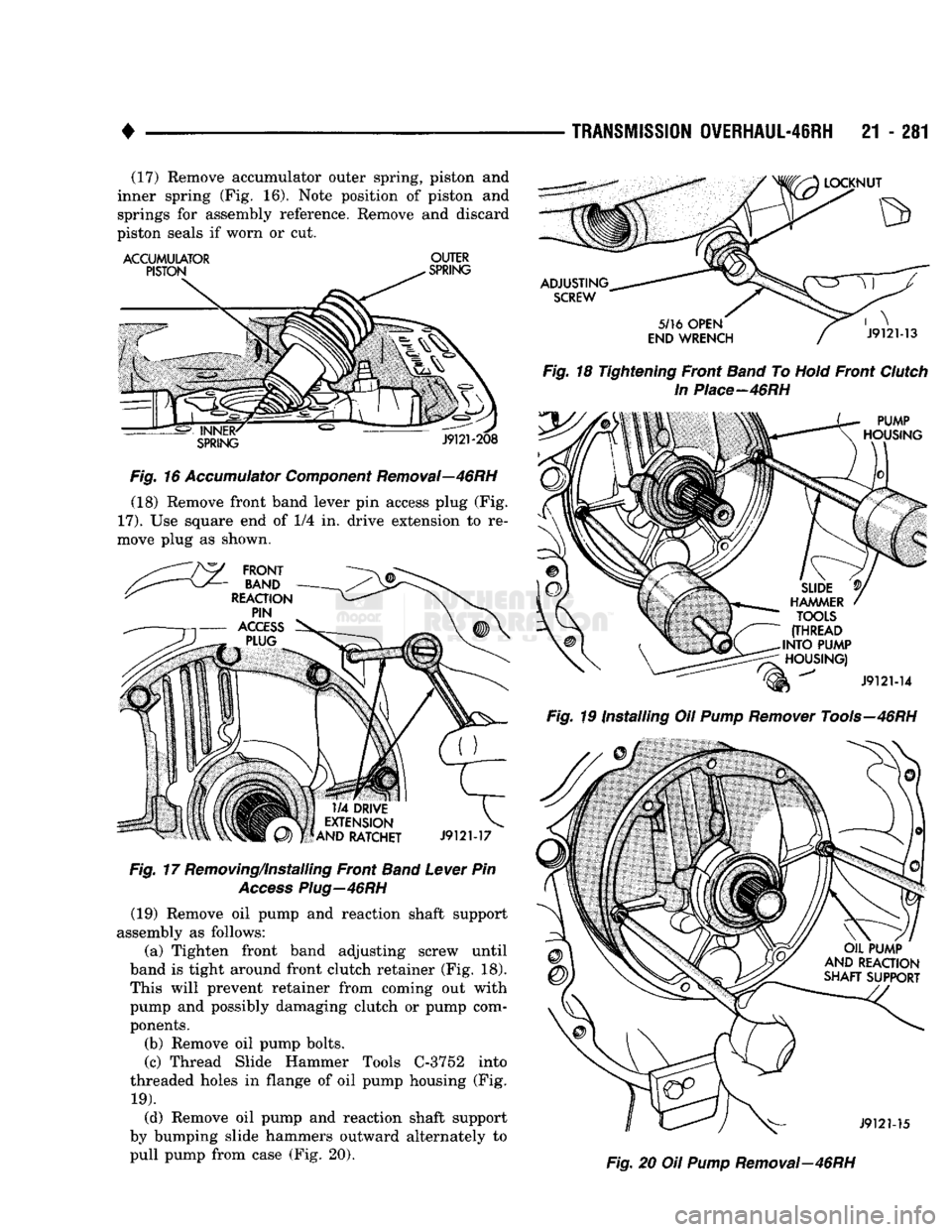
•
TRANSMISSION
OVERHAUL-46RH
21 - 281 (17) Remove accumulator outer spring, piston and
inner spring (Fig. 16). Note position of piston and
springs for assembly reference. Remove and discard
piston seals if worn or cut.
ACCUMULATOR
OUTER
Fig.
16
Accumulator
Component
Removal--46RH (18) Remove front band lever pin access plug (Fig.
17).
Use square end of 1/4 in. drive extension to re
move plug as shown.
Fig.
17 Removing/Installing Front
Band
Lever
Pin
Access
Plug—46RH
(19) Remove oil pump and reaction shaft support
assembly as follows:
(a) Tighten front band adjusting screw until
band is tight around front clutch retainer (Fig. 18).
This will prevent retainer from coming out with
pump and possibly damaging clutch or pump com
ponents.
(b) Remove oil pump bolts.
(c) Thread Slide Hammer Tools C-3752 into
threaded holes in flange of oil pump housing (Fig.
19).
(d) Remove oil pump and reaction shaft support
by bumping slide hammers outward alternately to
pull pump from case (Fig. 20).
Fig.
18 Tightening Front
Band
To
Hold
Front
Clutch
In
Piace-46RH
Fig.
19 Installing Oil
Pump
Remover
Tools—46RH
Fig.
20 Oil
Pump
Removal—46RH
Page 1283 of 1502
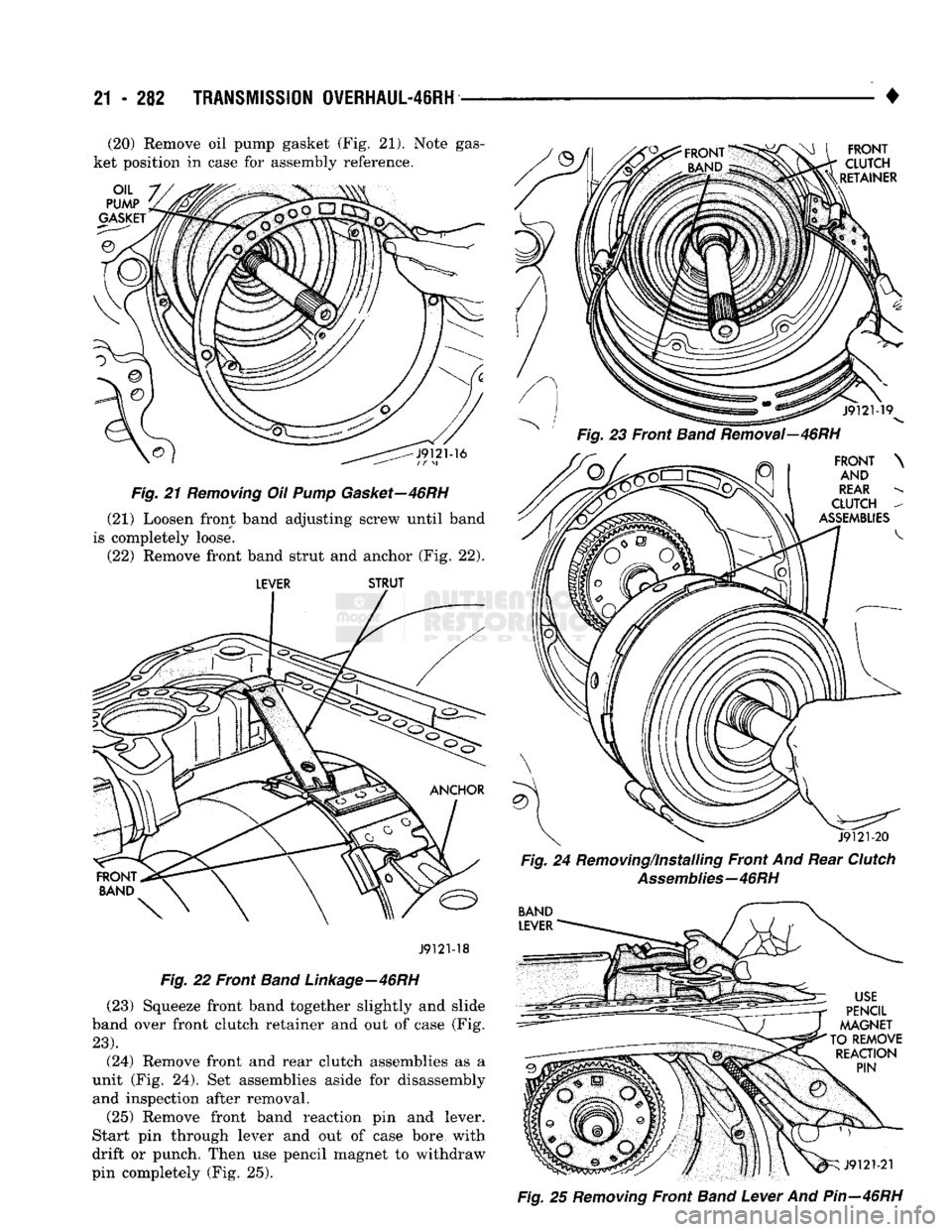
21
- 282
TRANSMISSION OVERHAUL-46RH
• (20) Remove oil pump gasket (Fig. 21). Note gas
ket position in case for assembly reference.
Fig.
21
Removing
Oil
Pump
Gasket—46RH
(21) Loosen front band adjusting screw until band
is completely loose.
(22) Remove front band strut and anchor (Fig. 22).
LEVER
STRUT
J9121-18
Fig.
22 Front
Band
Linkage—46RH
(23) Squeeze front band together slightly and slide
band over front clutch retainer and out of case (Fig.
23).
(24) Remove front and rear clutch assemblies as a
unit (Fig. 24). Set assemblies aside for disassembly and inspection after removal. (25) Remove front band reaction pin and lever.
Start pin through lever and out of case bore with
drift or punch. Then use pencil magnet to withdraw
pin completely (Fig. 25).
Fig.
24 Removing/Installing Front And Rear
Clutch
Assemblies—46RH
Fig.
25
Removing
Front
Band
Lever
And
Pin—46RH
Page 1284 of 1502
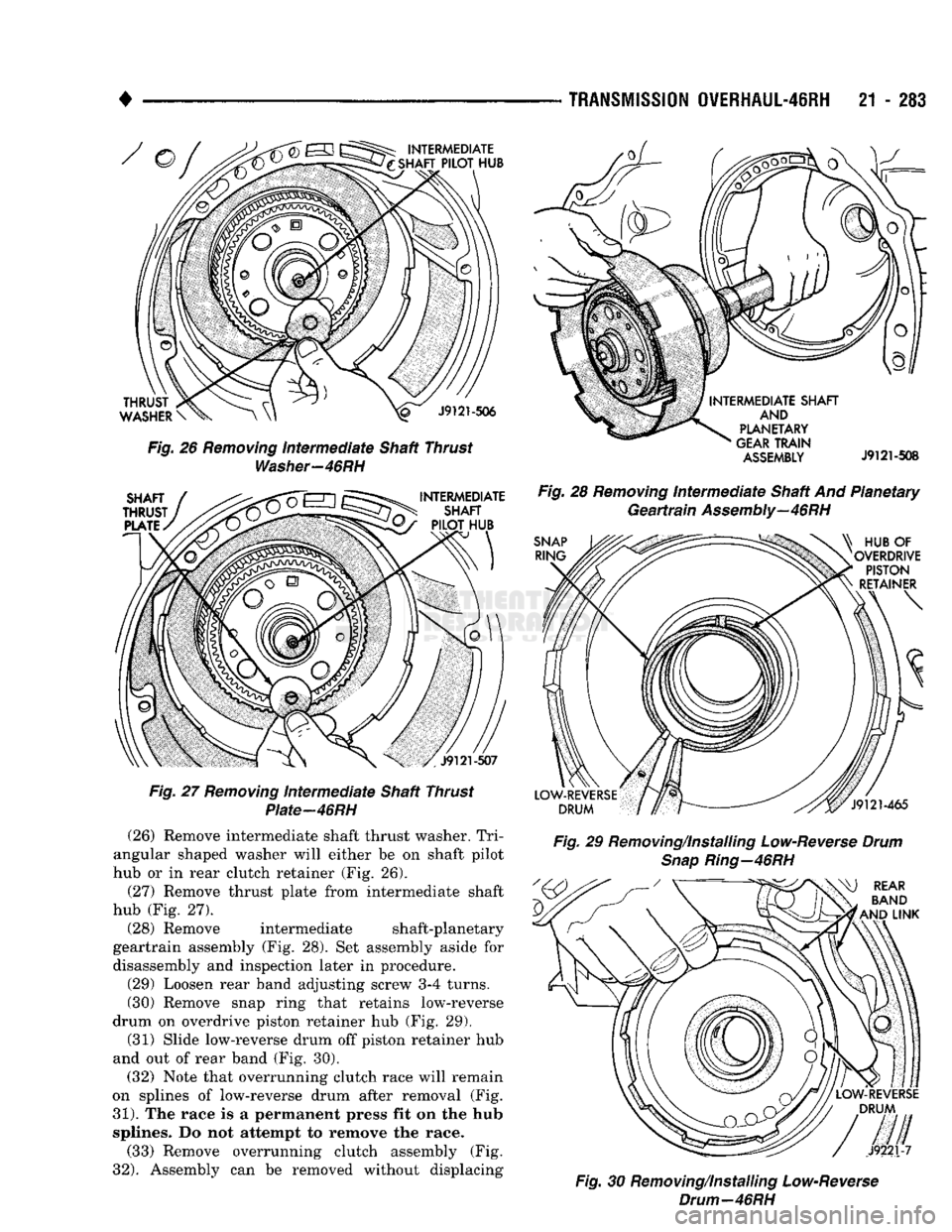
•
Fig.
26
Removing
intermediate
Shaft Thrust
Washer-46RH
Fig.
27
Removing
intermediate
Shaft Thrust Plate-46RH (26) Remove intermediate shaft thrust washer. Tri
angular shaped washer will either be on shaft pilot
hub or in rear clutch retainer (Fig. 26).
(27) Remove thrust plate from intermediate shaft
hub (Fig. 27).
(28) Remove intermediate shaft-planetary
geartrain assembly (Fig. 28). Set assembly aside for
disassembly and inspection later in procedure. (29) Loosen rear band adjusting screw 3-4 turns.
(30) Remove snap ring that retains low-reverse
drum on overdrive piston retainer hub (Fig. 29). (31) Slide low-reverse drum off piston retainer hub
and out of rear band (Fig. 30).
(32) Note that overrunning clutch race will remain
on splines of low-reverse drum after removal (Fig.
31).
The race is a permanent press fit on the hub splines. Do not attempt to remove the race.
(33) Remove overrunning clutch assembly (Fig.
32).
Assembly can be removed without displacing
TRANSMISSION
0WERHAUL-46RH
21 - 283
ASSEMBLY J9121-508
Fig.
28
Removing
Intermediate
Shaft And Planetary
Geartrain
Assembly—46RH
Fig.
29 Removing/Installing
Low-Reverse
Drum
Snap
Ring—46RH
Fig.
30 Removing/Installing
Low-Reverse
Drum—46RH
Page 1285 of 1502
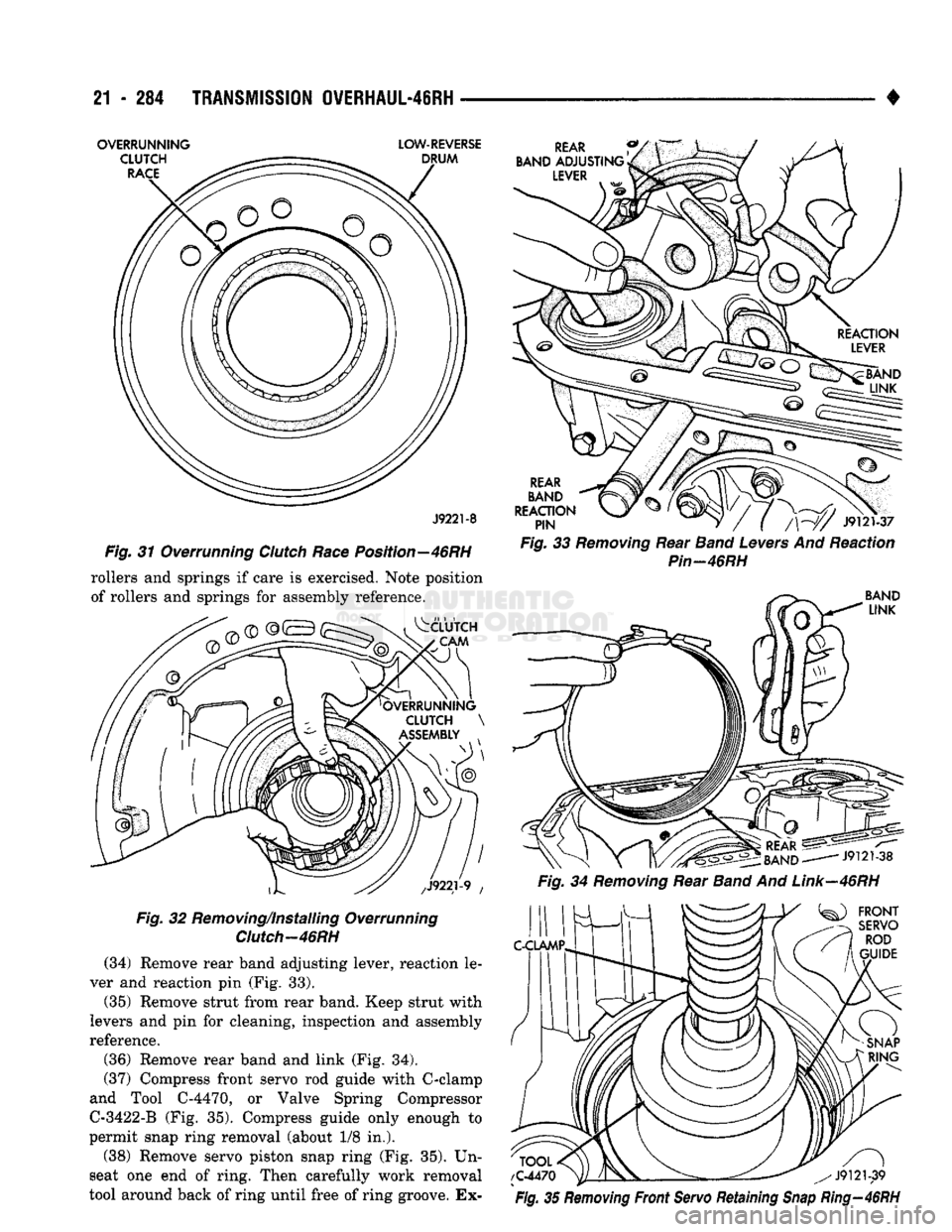
21
- 284
TRANSMISSION
0¥ERHAUL-46RH
OVERRUNNING CLUTCH
RACE
LOW-REVERSE
DRUM
REAR
BAND
ADJUSTING
LEVER
J9221-8
Fig.
31 Overrunning
Clutch
Race
Position—46RH rollers and springs if care is exercised. Note position
of rollers and springs for assembly reference.
^CLUTCH
CAM
Fig.
32 Removing/Installing Overrunning
Clutch-46RH
(34) Remove rear band adjusting lever, reaction le
ver and reaction pin (Fig. 33).
(35) Remove strut from rear band. Keep strut with
levers and pin for cleaning, inspection and assembly
reference.
(36) Remove rear band and link (Fig. 34).
(37) Compress front servo rod guide with C-clamp
and Tool C-4470, or Valve Spring Compressor
C-3422-B (Fig. 35). Compress guide only enough to
permit snap ring removal (about 1/8 in.).
(38) Remove servo piston snap ring (Fig. 35). Un
seat one end of ring. Then carefully work removal
tool around back of ring until free of ring groove. Ex-
REAR
BAND
REACTION
_ ^, , ,
PIN ~ y / ( /\~y/ J9121-37
Fig.
33
Removing
Rear
Band
Levers
And Reaction
Pin-46RH
BAND
LINK
-J9121-38
Fig.
34
Removing
Rear
Band
And
Link—46RH
^) FRCNT
SERVO
ROD
GUIDE
TOOL
/C4470 J9121-39
Fig.
35
Removing
Front
Servo
Retaining
Snap
Ring-46RH
Page 1286 of 1502
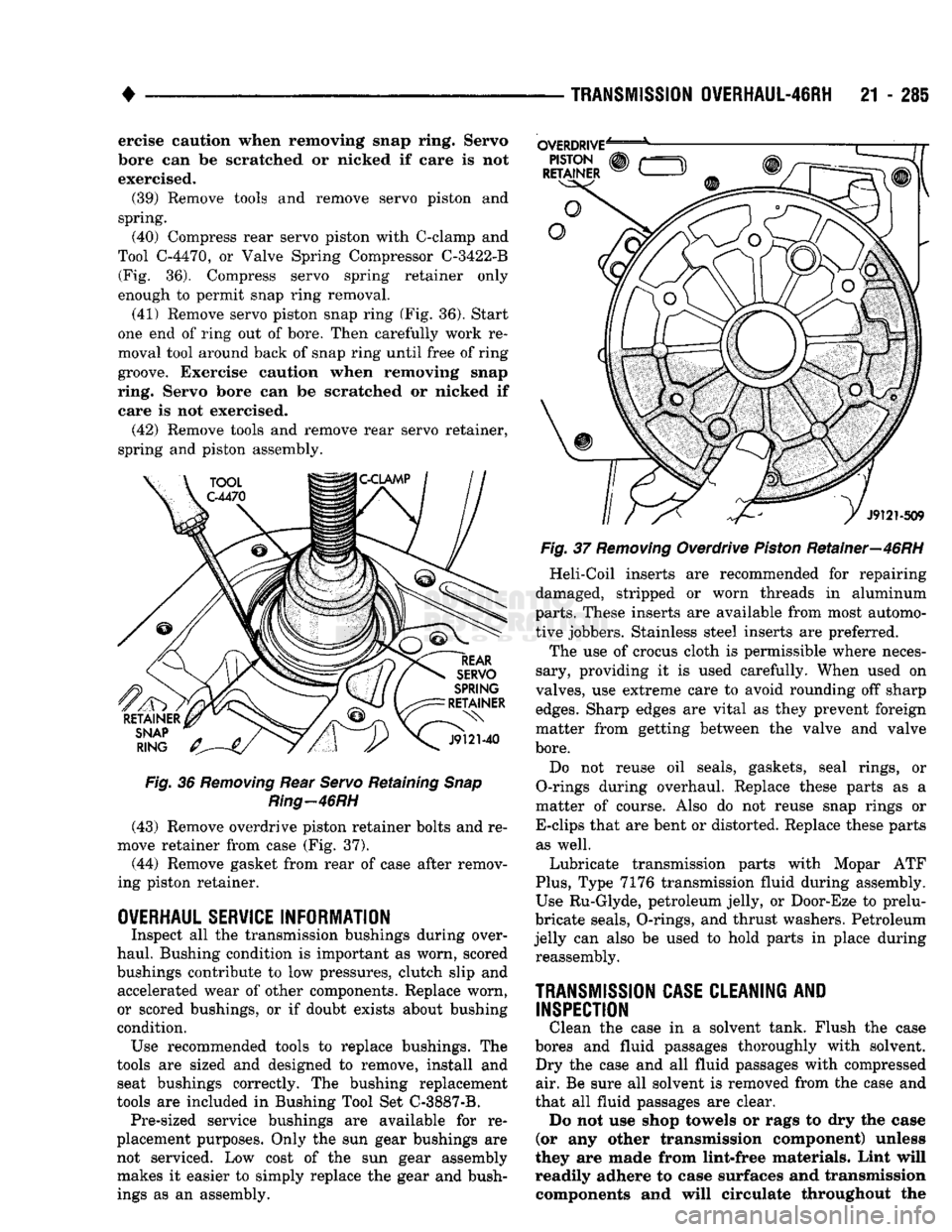
•
TRANSMISSION
OVERHAUL-46RH
21 - 285 ercise caution when removing snap ring. Servo
bore can be scratched or nicked if care is not
exercised.
(39)
Remove tools and remove servo piston and
spring.
(40)
Compress rear servo piston with C-clamp and
Tool C-4470, or Valve Spring Compressor C-3422-B (Fig. 36). Compress servo spring retainer only
enough to permit snap ring removal.
(41) Remove servo piston snap ring (Fig. 36). Start
one end of ring out of bore. Then carefully work re
moval tool around back of snap ring until free of ring
groove. Exercise caution when removing snap
ring. Servo bore can be scratched or nicked if care is not exercised.
(42) Remove tools and remove rear servo retainer,
spring and piston assembly.
Fig.
36
Removing
Rear
Servo
Retaining
Snap
Ring—46RH
(43) Remove overdrive piston retainer bolts and re
move retainer from case (Fig. 37).
(44) Remove gasket from rear of case after remov
ing piston retainer.
OVERHAUL SERVICE
INFORMATION
Inspect all the transmission bushings during over
haul. Bushing condition is important as worn, scored
bushings contribute to low pressures, clutch slip and accelerated wear of other components. Replace worn,
or scored bushings, or if doubt exists about bushing
condition. Use recommended tools to replace bushings. The
tools are sized and designed to remove, install and seat bushings correctly. The bushing replacement
tools are included in Bushing Tool Set C-3887-B. Pre-sized service bushings are available for re
placement purposes. Only the sun gear bushings are not serviced. Low cost of the sun gear assembly makes it easier to simply replace the gear and bushings as an assembly.
Fig.
37
Removing
Overdrive
Piston
Retainer—46RH
Heli-Coil inserts are recommended for repairing
damaged, stripped or worn threads in aluminum
parts.
These inserts are available from most automo
tive jobbers. Stainless steel inserts are preferred.
The use of crocus cloth is permissible where neces
sary, providing it is used carefully. When used on
valves, use extreme care to avoid rounding off sharp
edges.
Sharp edges are vital as they prevent foreign
matter from getting between the valve and valve
bore.
Do not reuse oil seals, gaskets, seal rings, or
O-rings during overhaul. Replace these parts as a
matter of course. Also do not reuse snap rings or
E-clips that are bent or distorted. Replace these parts as well.
Lubricate transmission parts with Mopar ATF
Plus,
Type 7176 transmission fluid during assembly.
Use Ru-Glyde, petroleum jelly, or Door-Eze to prelu-
bricate seals, O-rings, and thrust washers. Petroleum
jelly can also be used to hold parts in place during reassembly.
TRANSMISSION
CASE
CLEANING
AND
INSPECTION
Clean the case in a solvent tank. Flush the case
bores and fluid passages thoroughly with solvent. Dry the case and all fluid passages with compressed air. Be sure all solvent is removed from the case and
that all fluid passages are clear. Do not use shop towels or rags to dry the case
(or any other transmission component) unless
they are made from lint-free materials. Lint will readily adhere to case surfaces and transmission components and will circulate throughout the
Page 1287 of 1502
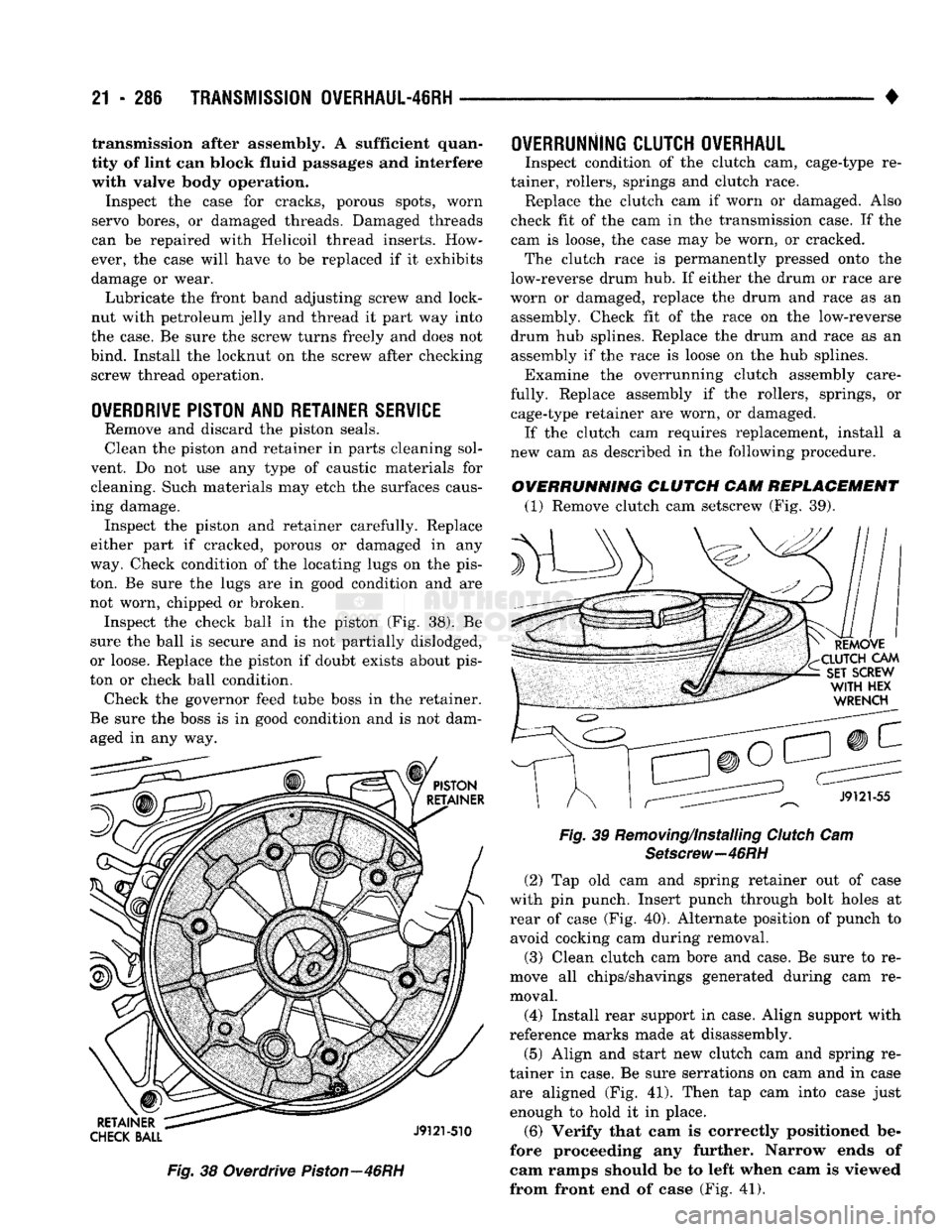
21 - 286
TRANSMISSION OVERHAUL-46RH
• transmission after assembly. A sufficient quan
tity of lint can block fluid passages and Interfere
with valve body operation.
Inspect the case for cracks, porous spots, worn
servo bores, or damaged threads. Damaged threads
can be repaired with Helicoil thread inserts. How
ever, the case will have to be replaced if it exhibits
damage or wear.
Lubricate the front band adjusting screw and lock-
nut with petroleum jelly and thread it part way into
the case. Be sure the screw turns freely and does not
bind. Install the locknut on the screw after checking screw thread operation.
OVERDRIVE PISTON AND RETAINER SERVICE
Remove and discard the piston seals.
Clean the piston and retainer in parts cleaning sol
vent. Do not use any type of caustic materials for
cleaning. Such materials may etch the surfaces caus
ing damage. Inspect the piston and retainer carefully. Replace
either part if cracked, porous or damaged in any way. Check condition of the locating lugs on the pis
ton. Be sure the lugs are in good condition and are not worn, chipped or broken. Inspect the check ball in the piston (Fig. 38). Be
sure the ball is secure and is not partially dislodged,
or loose. Replace the piston if doubt exists about pis
ton or check ball condition. Check the governor feed tube boss in the retainer.
Be sure the boss is in good condition and is not dam aged in any way.
Fig.
38 Overdrive
Piston—46RH
OWERRUNNlNG CLUTCH OVERHAUL
Inspect condition of the clutch cam, cage-type re
tainer, rollers, springs and clutch race. Replace the clutch cam if worn or damaged. Also
check fit of the cam in the transmission case. If the
cam is loose, the case may be worn, or cracked. The clutch race is permanently pressed onto the
low-reverse drum hub. If either the drum or race are
worn or damaged, replace the drum and race as an assembly. Check fit of the race on the low-reverse
drum hub splines. Replace the drum and race as an assembly if the race is loose on the hub splines. Examine the overrunning clutch assembly care
fully. Replace assembly if the rollers, springs, or cage-type retainer are worn, or damaged. If the clutch cam requires replacement, install a
new cam as described in the following procedure.
OVERRUNNING CLUTCH CAM REPLACEMENT (1) Remove clutch cam setscrew (Fig. 39).
Fig.
39 Removing/Installing
Clutch
Cam
Setscrew—46RH
(2)
Tap old cam and spring retainer out of case
with pin punch. Insert punch through bolt holes at rear of case (Fig. 40). Alternate position of punch to avoid cocking cam during removal.
(3) Clean clutch cam bore and case. Be sure to re
move all chips/shavings generated during cam re moval.
(4) Install rear support in case. Align support with
reference marks made at disassembly. (5) Align and start new clutch cam and spring re
tainer in case. Be sure serrations on cam and in case are aligned (Fig. 41). Then tap cam into case just
enough to hold it in place.
(6) Verify that cam is correctly positioned be
fore proceeding any further. Narrow ends of
cam ramps should be to left when cam is viewed
from front end of case (Fig. 41).
Page 1288 of 1502
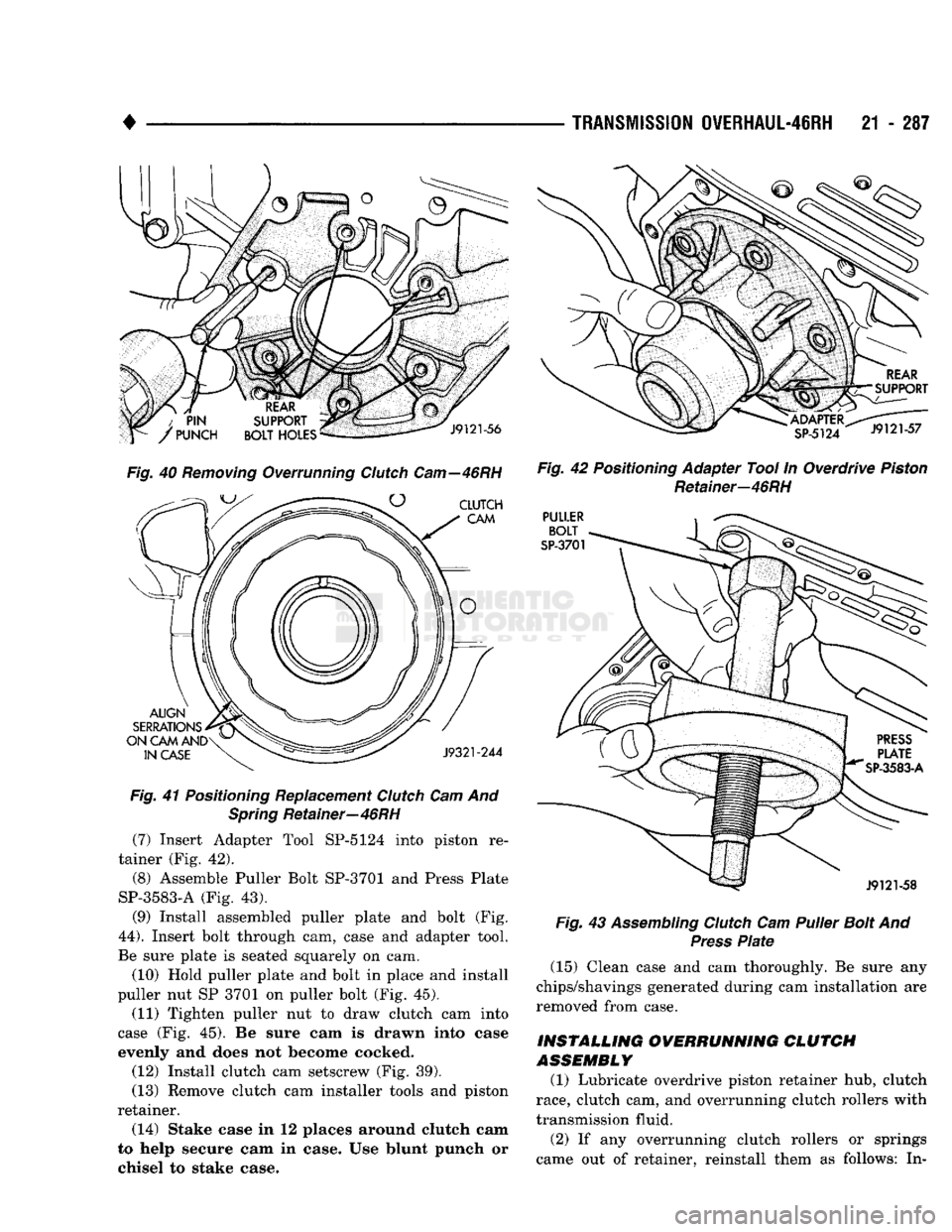
•
Fig. 40 Removing Overrunning Clutch Cam—46RH Fig. 41 Positioning Replacement Clutch Cam And
Spring Retainer—46RH
(7) Insert Adapter Tool SP-5124 into piston re
tainer (Fig. 42).
(8) Assemble Puller Bolt SP-3701 and Press Plate
SP-3583-A (Fig. 43). (9) Install assembled puller plate and bolt (Fig.
44).
Insert bolt through cam, case and adapter tool.
Be sure plate is seated squarely on cam.
(10) Hold puller plate and bolt in place and install
puller nut SP 3701 on puller bolt (Fig. 45).
(11) Tighten puller nut to draw clutch cam into
case (Fig. 45). Be sure cam is drawn into case
evenly and does not become cocked.
(12) Install clutch cam setscrew (Fig. 39).
(13) Remove clutch cam installer tools and piston
retainer.
(14) Stake case in 12 places around clutch cam
to help secure cam in case. Use blunt punch or chisel to stake case.
TRANSMISSION
0WERHAUL-48RH
21 - 287
Fig. 43 Assembling Clutch Cam Puller Bolt And Press Plate (15) Clean case and cam thoroughly. Be sure any
chips/shavings generated during cam installation are
removed from case.
INSTALLING OVERRUNNING CLUTCH
ASSEMBLY
(1) Lubricate overdrive piston retainer hub, clutch
race,
clutch cam, and overrunning clutch rollers with
transmission fluid.
(2) If any overrunning clutch rollers or springs
came out of retainer, reinstall them as follows: In-
Page 1289 of 1502
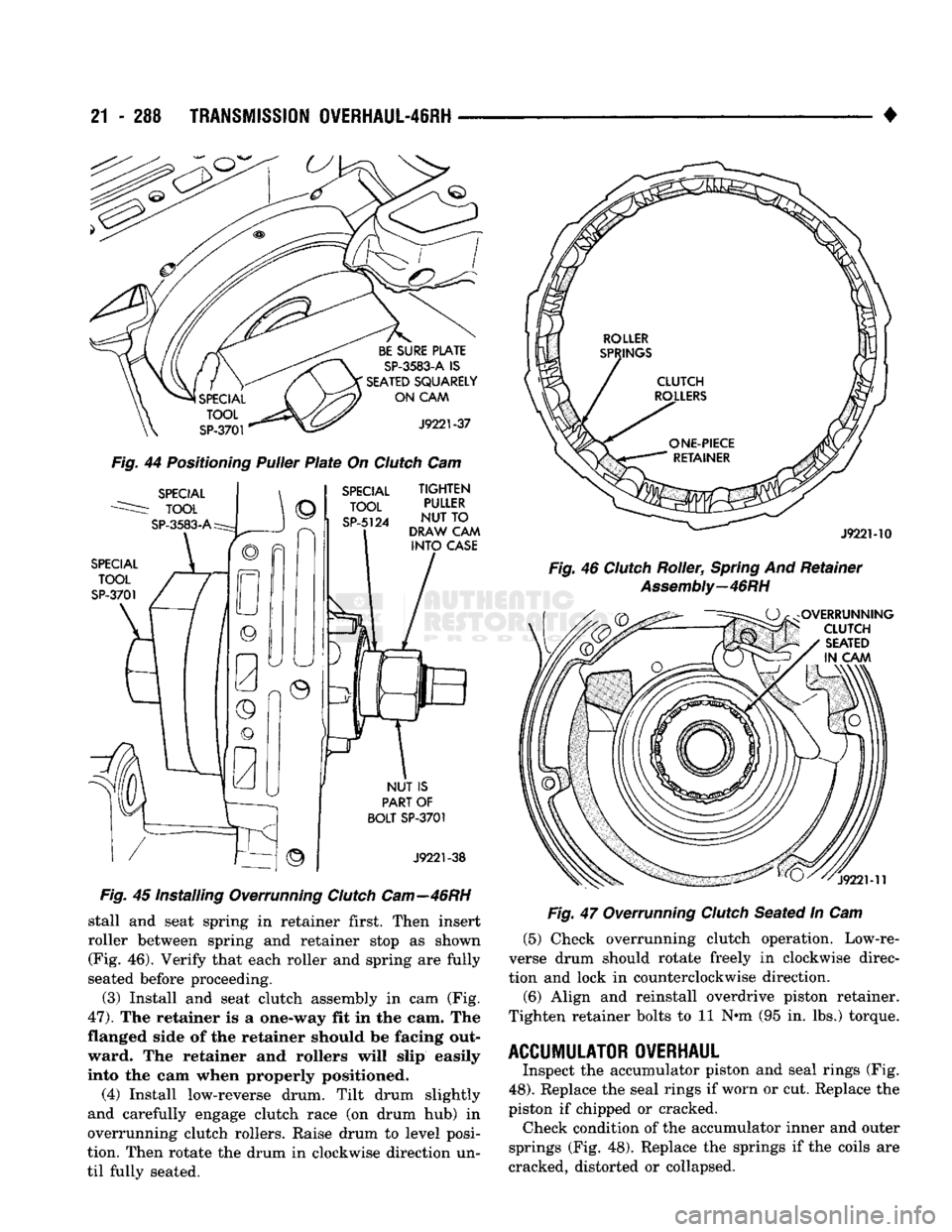
21
- 288
TRANSMISSION OVERHAUL-48RH
Fig.
44
Positioning
Puller
Plate
On
Clutch
Cam
Fig.
45 Installing Overrunning
Clutch
Cam—46RH
stall and seat spring in retainer first. Then insert
roller between spring and retainer stop as shown (Fig. 46). Verify that each roller and spring are fully
seated before proceeding.
(3) Install and seat clutch assembly in cam (Fig.
47).
The retainer is a one-way fit in the cam. The
flanged side of the retainer should be facing out ward. The retainer and rollers will slip easily
into the cam when properly positioned.
(4) Install low-reverse drum. Tilt drum slightly
and carefully engage clutch race (on drum hub) in
overrunning clutch rollers. Raise drum to level posi
tion. Then rotate the drum in clockwise direction un
til fully seated. •
Fig.
47 Overrunning
Clutch
Seated In Cam (5) Check overrunning clutch operation. Low-re
verse drum should rotate freely in clockwise direc
tion and lock in counterclockwise direction.
(6) Align and reinstall overdrive piston retainer.
Tighten retainer bolts to 11 N*m (95 in. lbs.) torque.
ACCUMULATOR OVERHAUL
Inspect the accumulator piston and seal rings (Fig.
48).
Replace the seal rings if worn or cut. Replace the
piston if chipped or cracked. Check condition of the accumulator inner and outer
springs (Fig. 48). Replace the springs if the coils are
cracked, distorted or collapsed.
Page 1290 of 1502
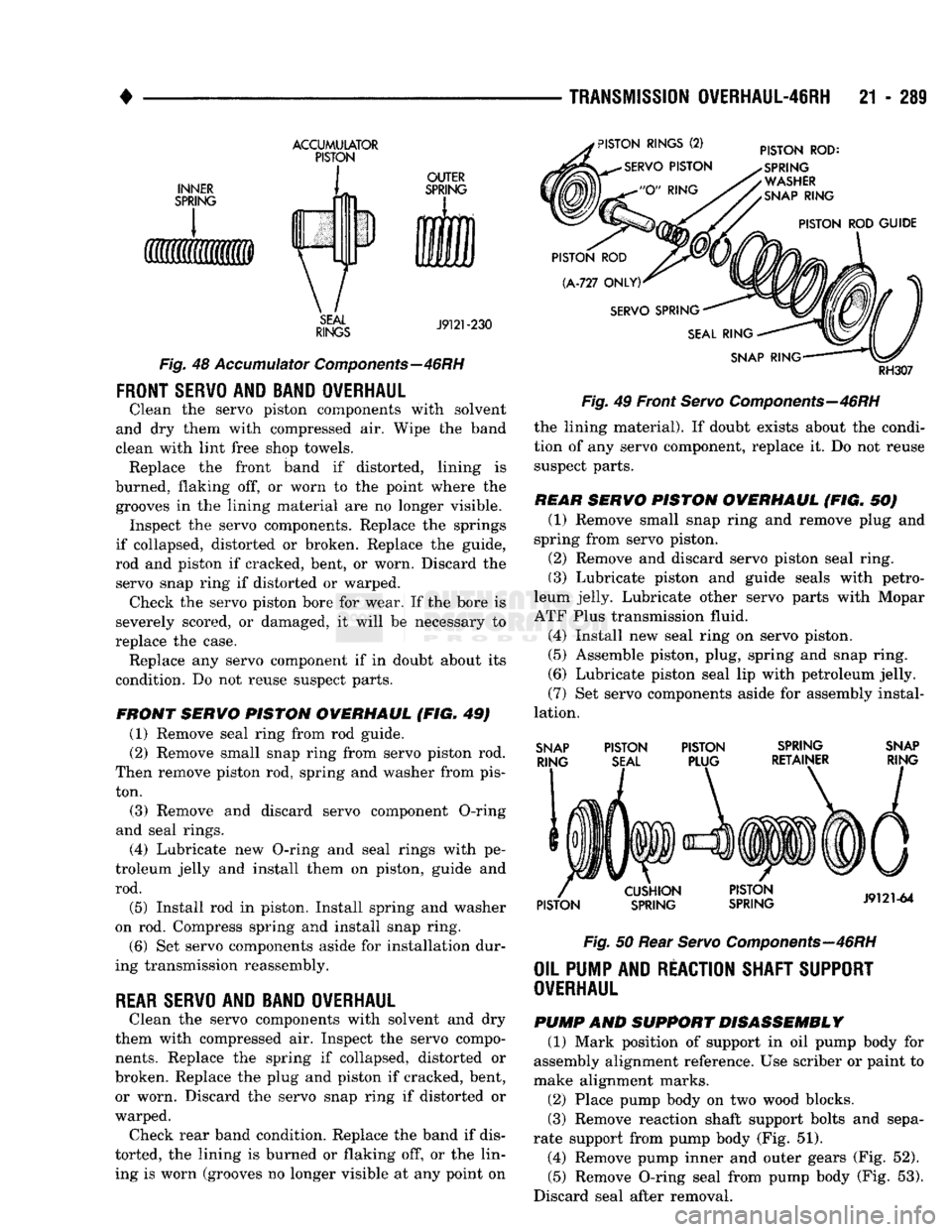
TRANSMISSION
0VERHAUL-46RH
21 - 289
ACCUMULATOR PISTON
INNER
SPRING
OUTER
SPRING
SEAL
RINGS
J9121-230
Fig.
48
Accumulator
Components—46RH
FRONT
SERVO
AND BAND OVERHAUL
Clean the servo piston components with solvent
and dry them with compressed air. Wipe the band
clean with lint free shop towels. Replace the front band if distorted, lining is
burned, flaking off, or worn to the point where the grooves in the lining material are no longer visible. Inspect the servo components. Replace the springs
if collapsed, distorted or broken. Replace the guide,
rod and piston if cracked, bent, or worn. Discard the servo snap ring if distorted or warped. Check the servo piston bore for wear. If the bore is
severely scored, or damaged, it will be necessary to
replace the case. Replace any servo component if in doubt about its
condition. Do not reuse suspect parts.
FRONT
SERVO PISTON OVERHAUL
(FIG. 49) (1) Remove seal ring from rod guide. (2) Remove small snap ring from servo piston rod.
Then remove piston rod, spring and washer from pis ton.
(3) Remove and discard servo component O-ring
and seal rings.
(4) Lubricate new O-ring and seal rings with pe
troleum jelly and install them on piston, guide and rod.
(5) Install rod in piston. Install spring and washer
on rod. Compress spring and install snap ring.
(6) Set servo components aside for installation dur
ing transmission reassembly.
REAR
SERVO AND BAND OVERHAUL
Clean the servo components with solvent and dry
them with compressed air. Inspect the servo compo
nents.
Replace the spring if collapsed, distorted or
broken. Replace the plug and piston if cracked, bent, or worn. Discard the servo snap ring if distorted or
warped. Check rear band condition. Replace the band if dis
torted, the lining is burned or flaking off, or the lin ing is worn (grooves no longer visible at any point on
PISTON RINGS
(2)
SERVO
PISTON O" RING PISTON
ROD:
•
SPRING
<
WASHER
.SNAP
RING
PISTON
ROD
GUIDE
PISTON
ROD (A-727
ONLY)'
SERVO
SPRING-
SEAL
RING.
SNAP
RING-
RH307
Fig.
49 Front
Servo
Components—46RH
the lining material). If doubt exists about the condi
tion of any servo component, replace it. Do not reuse
suspect parts.
REAR
SERVO PISTON OVERHAUL
(FIG. 50) (1) Remove small snap ring and remove plug and
spring from servo piston. (2) Remove and discard servo piston seal ring.
(3) Lubricate piston and guide seals with petro
leum jelly. Lubricate other servo parts with Mopar
ATF Plus transmission fluid.
(4) Install new seal ring on servo piston.
(5) Assemble piston, plug, spring and snap ring.
(6) Lubricate piston seal lip with petroleum jelly.
(7) Set servo components aside for assembly instal
lation.
SNAP
RING PISTON
SEAL
PISTON
PLUG
SPRING
RETAINER
SNAP
RING
PISTON CUSHION
SPRING
PISTON
SPRING
J9121-64
Fig.
50 Rear
Servo
Components—46RH
OIL PUMP AND REACTION SHAFT SUPPORT
OVERHAUL
PUMP
AND
SUPPORT DISASSEMBLY
(1) Mark position of support in oil pump body for
assembly alignment reference. Use scriber or paint to
make alignment marks.
(2) Place pump body on two wood blocks. (3) Remove reaction shaft support bolts and sepa
rate support from pump body (Fig. 51). (4) Remove pump inner and outer gears (Fig. 52).
(5) Remove O-ring seal from pump body (Fig. 53).
Discard seal after removal.